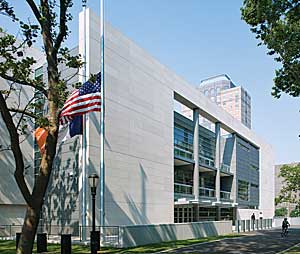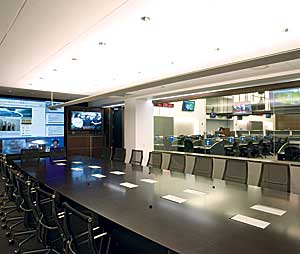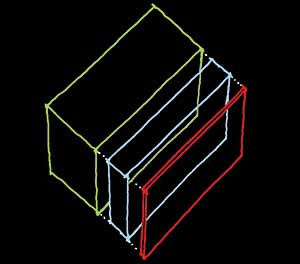Safety and Security Without the Fortress Look
This facade strategy also screened the interior from view while allowing daylight into the building. For example, the "folded" entry elevation, clad in limestone, presents a seemingly impervious facade from the street. But hidden between the folds are windows that provide plenty of daylight for the reception area. Similarly, the copper scrim protects office windows, but allows daylight to filter through its perforations. "We tried to turn the project requirements into an architectural opportunity," says Avi Lothan, DeStefano design partner.
The veiled approach not only addressed scheduling and security concerns, but also provided protection from natural disasters. The impact load of a tree thrown into a window during a hurricane or tornado can be more difficult to design for than terrorist activity, according to Lothan. However, the screens act as a "sacrificial" layer and safeguard the glazing from such loads, he says. The copper, also used to create an enclosure for rooftop equipment, has the added benefit of shielding electromagnetic interference that could disrupt telecommunications, points out Michael Kuppinger, senior vice president of ESD, Chicago, the project's mechanical and technology consultant.
Â
Â
|
||||||
Â
In case a natural disaster or terrorist activity compromises municipal services providing power, water, or sewage disposal, the SEOC, like most mission-critical facilities, incorporates many redundancies. It has a diesel generator and storage for potable water and mechanical system make-up water, allowing the building to function independently for up to three days, even in a "doomsday scenario," say Lothan.
Natural disasters were also a key concern for designers of the Los Angeles Emergency Operations Center (LA EOC), a county facility now under construction at the edge of Little Tokyo. "The building must remain operational after a major event," says Ernest Cirangle, AIA, HOK design principal. "And the most likely event here is an earthquake." To ensure that the LA EOC can withstand a large magnitude temblor, the 82,000-square-foot, two-story building is base-isolated and surrounded by a 4-foot-wide moat. Complicating the design of the friction-pendulum seismic-isolation system is an immediately adjacent fixed-base fire station that shares dispatch facilities with the EOC. The two buildings are connected on two levels with a corridor, but are otherwise separated by an 11-foot gap.
The EOC's structural integrity after a quake was not the design team's only worry. Because the building's "lifelines" must also remain intact, its power, gas, and water supply all have flexible connections to accommodate ground motion, says Cirangle.














